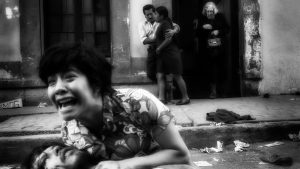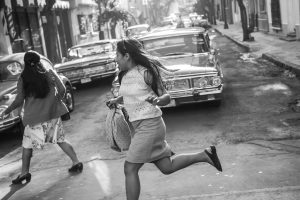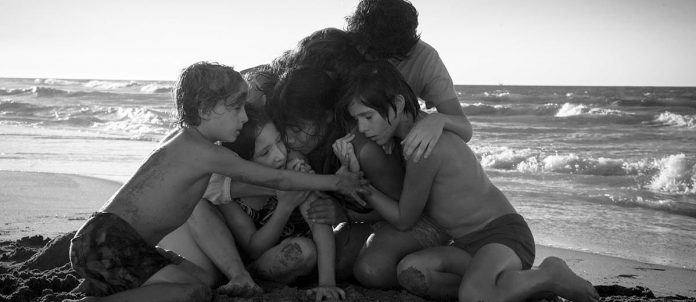(THIS ARTICLE IS MACHINE TRANSLATED by Google from Norwegian)
Six years after the Oscar-winning giant success Gravity, with actors Sandra Bullock and George Clooney, the director, screenwriter, photographer and filmmaker Alfonso Cuarón is ready with a new movie: Roma. In September, it peaked at the Venice Film Festival, and the director was able to take the Golden Lion home to Mexico City.
The hometown is also the scene of Roma. For the first time in 16 years, not since the breakthrough And your mom, too, he has made a film with his native language, Spanish. This time, he also includes the language of Mixtic, spoken by the Native American population of Mexico.
Tribute to the women
Roma is Alfonso's by far the most personal film project to date. We come into close contact with the life of a middle class family in Mexico City for one year, early in the 70 century. In the house lives mother, father and four children – three boys and a girl. The youngest is built on Alfonso himself, and is ten years old. Also – and not least – the family maid (and the mother's reserve), which in Mexican tradition is almost 100 percent part of the family.
His father left his wife and children. Thus Alfonso focuses on the two most important women in his upbringing: his biological mother and the woman he still calls his "other mother". Roma is not so much a memoir as it is a tribute to the sacrifices women make for the family – both their own and the one they take care of through their work as a domestic worker. Marina de Tavira, who plays the mother, is the film's only professional actor, and known from film, television and especially theater. Yalitza Aparicio, who holds the film's other major role, is an amateur, but at least as impressive on the screen.
The film is Cuarón's best so far, and has exceptionally beautiful scenes.
The director has been almost obsessed with his attention to detail – everything should be as close as possible to the reality he remembers. Sometimes quite literally, like when the house it is filmed in, is filled with furniture and other things from the family's original home. It is essential that every actor should look like the people they are going to portray.
 Roma is, according to Cuarón, an attempt to capture memories of experiences he had almost fifty years ago. It is a study of Mexico's social hierarchy, where class and ethnicity are perversely merged right up to our time. As a child, he knew neither the maid's life outside the walls of his own family, nor the family activities she participated in. Only now, after long conversations, has he gained new insight. Growing up, almost exclusively among women, has given him a kind of understanding of love that is almost mysteriously needed through space, memories and time.
Roma is, according to Cuarón, an attempt to capture memories of experiences he had almost fifty years ago. It is a study of Mexico's social hierarchy, where class and ethnicity are perversely merged right up to our time. As a child, he knew neither the maid's life outside the walls of his own family, nor the family activities she participated in. Only now, after long conversations, has he gained new insight. Growing up, almost exclusively among women, has given him a kind of understanding of love that is almost mysteriously needed through space, memories and time.
Events around the basically peaceful student demonstration close by, 10. June 1971, is in the movie. A black chapter in the history of Mexico City. The Corpus Christi massacre – named after the Catholic Feast of the Body of Christ, which was marked in Mexico that day – ended in a massacre. A new military police force blocked the way for close to 10 000 students and began shooting. Members of the paramilitary group Los Halcones (Falcons) ran after the wounded all the way to the hospital and killed them in front of doctors and nurses.
The middle class
The neighborhoods of Rome and Condesa, which are close by, both have a clear middle class feel. Partly a bohemian facade. That time, early in the 70, like today. They have managed to preserve this character despite the area being shaken by one of the biggest earthquakes that have hit Mexico City in recent times, in 1985. Some moved, many later moved back. Architecture, great parks, small design shops, cafes, large selection of eateries, small galleries, cinemas, super bookstore and more. As in similar areas in other countries, many artists, musicians, writers, actors and film people live in the area. In 2006 / 2007 I was a guest at a new fantastic film festival (which unfortunately no longer exists) in the city, and stayed at the architectural gem Condesa Df. Taquería El Califa, nearby, must have the world's best tapas, and is open until 4 o'clock in the morning all week.

Roma was originally to be photographed by Grand Master Emmanuel Lubezki, but he had to cancel when he was busy with another movie. Emmanuel urged Alfonso to manage photography himself (he is a trained cinematographer). The result is outstanding, monochrome monochrome and 65mm. Cross your fingers for Cinemateket to view it in 65mm and with Dolby Atmos. Some selected movie theaters in some cities may have movie previews before it is released on Netflix 14. December.
When Alfonso Cuarón in 2013 received the Oscar for best direction, he was the first from Mexico to receive it. Four of the last five directorial awards have gone to a Mexican director. Roma is his best so far and has exceptionally beautiful scenes. The scenes at the beach towards the end of the movie are brilliant.
Roma is clearly one of the favorites for the award for best non-English language film, but it is probably also nominated for several Academy Awards.
Mexico City is a monster, but a very beautiful monster.
The film will be shown on Cinemateket.
In Oslo 4. 5. and 6. December.
And it comes on Netflix. XX


